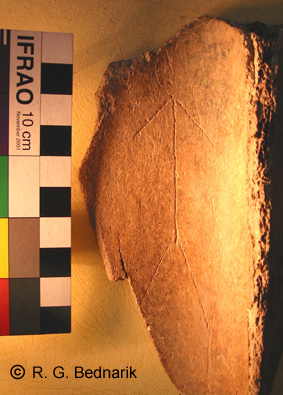Portable engravings
 The earliest figurative image known in the world, from the Micoquian of Oldisleben, Germany.
|
The earliest known engravings on portable objects of bone, ivory, shell and stone occur in the Lower Palaeolithic, but just as rock art of this period, they are rare finds. They include five engraved bone fragments (see image above) from the Holstein interglacial, >250 000 BP, at Bilzingsleben, Germany (Mania and Mania 1988), as well as a quartzite slab with arcuate engraving and an engraved fragment of a polished ivory point from the same site (Bednarik 1995a); a scoria pebble with several deep, apparently anthropic grooves that underline the object’s shape of a female figure, Acheulian, >230 000 years, Berekhat Ram, Israel (Goren-Inbar 1986; Goren-Inbar and Peltz 1995; d’Errico and Nowell 2000); a human figurine of quartzitic sandstone, also of the Acheulian, 300 000 to 500 000 years old, Tan Tan, Morocco (Bednarik 2003); an engraved freshwater mussel shell from the Homo erectus site Trinil in Java, possibly 500 000 years old (Joordens et al. 2014); an engraved stegodon tusk from Xinglongdong Cave, Three Gorges region, China, 150 000 years old (Gao et al. 2004); an engraved stone slab from Wonderwerk Cave in South Africa, 300 000 years old (Beaumont and Bednarik 2013); and a fragment of bone, probably of a horse, bearing ten cuts along its edge, from the Upper Acheulian of Sainte Anne I, at Polignac, Haute-Loire, France (Raynal and Séguy 1986; cf. Crémades 1996.).
The subsequent Middle Palaeolithic period (Middle Stone Age in sub-Saharan Africa) has yielded a considerably greater number of such finds. Bone fragments bearing engravings or serrations cut by stone tools are common, such as those from Schulen, Belgium (Huyge 1990); Bacho Kiro, Bulgaria (Marshack 1976); La Quina, France (Martin 1907-10; Marshack 1991); La Ferrassie, France (Capitan and Peyrony 1921; Marshack 1976); Tagliente shelter, Italy (Leonardi 1988); Cueva Morín, Spain (Freeman and Gonzalez Echegaray 1983); Taubach near Weimar, Germany (Kuckenburg 1997); Wyhlen near Lörrach, Germany (Kuckenburg 1996: 141, 1997); Abri Suard, Le Chaise-de-Vouthon, Charente, France (Duport 1960; Debénath and Duport 1971; Crémades 1996); Petit Puymoyen and Montgaudier (Débenath and Duport 1971; Crémades 1996); Peyrere 1 Cave, also called Noisetier Cave, near Arreau, Aure valley, France (d’Errico and Allard 1997); Prolom 2, Crimean peninsula (Stepanchuk 1993); Kebara Cave, Israel (Davis 1974); Klasies River Mouth, South Africa (Singer and Wymer 1982); Border Cave, Swaziland (Beaumont et al. 1978); and Apollo 11 Cave, Namibia (Wendt 1974). Similar engravings of the Middle Stone Age are known from three ostrich eggshell fragments in Dieplkloof Cave, South Africa. A notched fragment of antler comes from Grotte Vaufrey, France (Vincent 1988), and the Micoquian of Prolom 2 in Ukraine yielded an engraved horse canine (Stepanchuk 1993).
Middle Palaeolithic engravings are also known from several stone objects, including stone tools: from Temnata Cave near Karlukovo, Bulgaria (Crémades et al. 1995); Grotta dell’Alto, Italy (Leonardi 1988); Tagliente and Solinas shelters (Leonardi 1988); Tata, Hungary (Bednarik 1995a); Quneitra, Israel (Goren-Inbar 1990; Marshack 1996); and Qafzeh Cave, Israel (Hovers et al. 1997). With so many pre-Upper Palaeolithic engravings now known, it is possible to formulate the first generalising propositions about early art systems (Bednarik 1984, 1990c; Hodgson 2000), and it is salient that these differ most significantly from the dominant models traditional archaeology has produced over the past century or more. Combined with the careful application of taphonomic logic these revisionary theories promise to review the history of human cognitive evolution. It is important to appreciate that, in addressing entrenched misconceptions about the human past — which certainly exist widely in orthodox archaeology — palaeoart science needs to be radical and persistent (Bednarik 2001a). The evidence provided by palaeoart clearly refutes the most widely held views about art origins, and this needs to be pursued effectively.
R. G. Bednarik, 2002 (updated 2014)